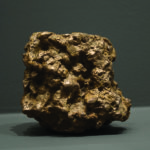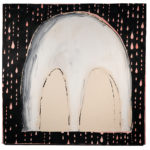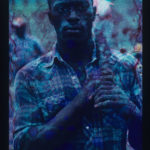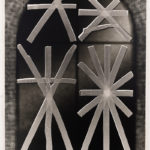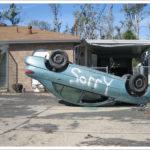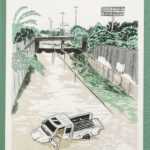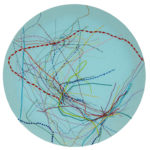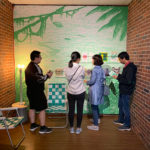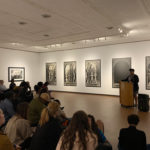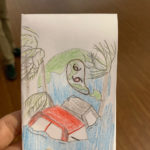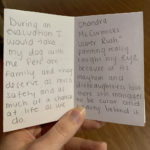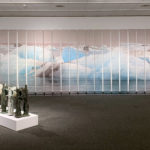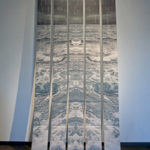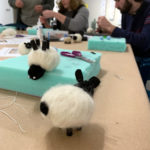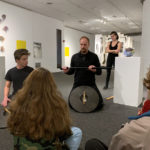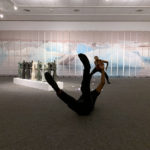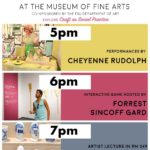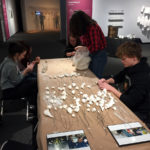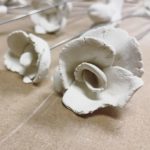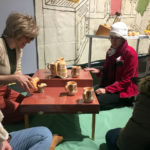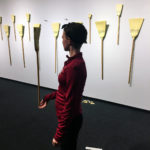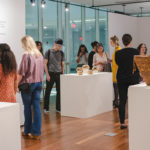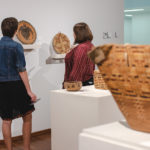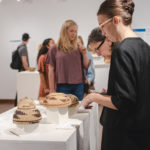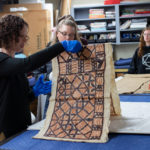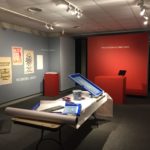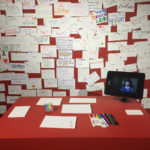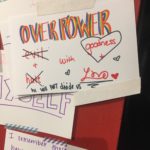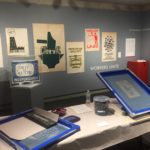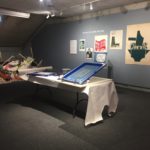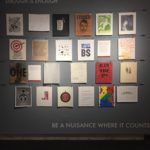Andy Warhol Foundation Supplemental Materials
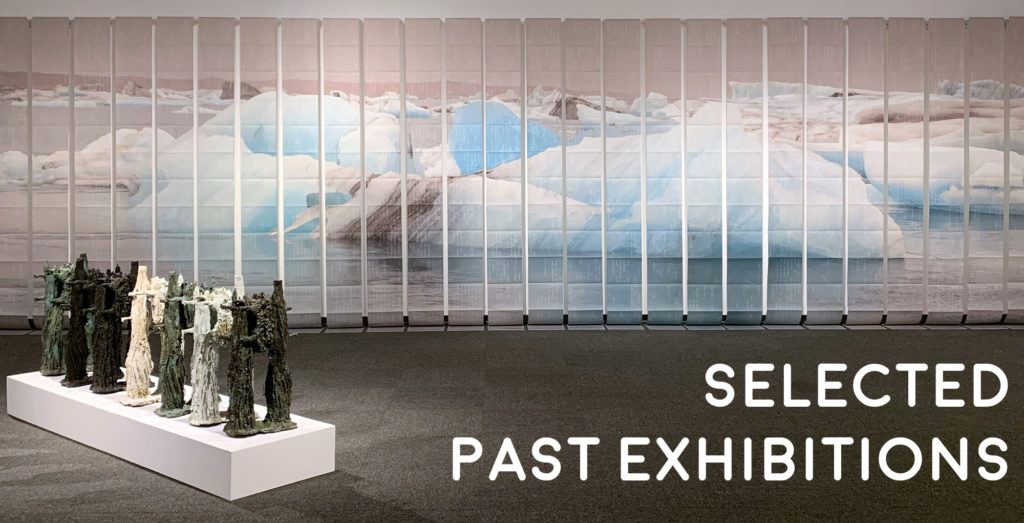
Elemental Iceland
Rising Water
January 18 – March 28, 2020
In the aftermath of Hurricane Michael, Tallahassee has been forced to reckon with a future that will include increasingly violent weather. Rising Water includes work by eight artists from across the United States who have been impacted by hurricanes. The exhibition shows a path forward that foregrounds creativity, empathy, and humanity in planning for a precarious future.
This exhibition features Willie Birch (New Orleans), Aspen Mays (Charleston), Chandra McCormick and Keith Calhoun (New Orleans), Trenton Doyle Hancock (Houston), Frances Gallardo (San Juan), Sarah Welch (Houston), and Richard Misrach (California and Louisiana).
- “Crawfish Dwelling” by Willie Birch
- “Fear” by Trenton Doyle Hancock
- “Mark Gale, Sugar Scrapper, Louisiana” by Chandra McCormick and Keith Calhoun
- “California Dreaming” by Aspen Mays
- “Destroy This Memory” by Richard Misrach
- “Sinking Truck” by Sarah Welch
- “The Unnamed” by Frances Gallardo
Rising Water Programming and Community Outreach
To support Rising Water, MoFA hosted free, public educational events every Thursday evening. Examples of programs include a poetry reading featuring local writers, an information session hosted by Campus Emergency Response Volunteers, a screening of the film “My Louisiana Love”, presentations by engineers and state officials who are leading efforts to prepare our region for climate change, and lectures by exhibiting artists Aspen Mays and Frances Gallardo.
In addition, a zine making table was installed in-gallery. Visitors were prompted to make a zine about their own hurricane experiences and leave it on book shelves installed in the exhibition. The artist collective Queer Appalachia came to Tallahassee and hosted a zine making workshop and throughout the show, Art Education students activated the space with informal demonstrations. At the close of the exhibition, the zines will be documented and studied by PhD candidates in the Visitor Centered Museum Studies program and will then be added to Special Collections at the FSU libraries.
- Visitors in the Zine Reading Room
- Diamond Forde reads her poetry
- A zine made by a visitor
- A zine made by a visitor
Elemental Iceland
October 14 – December 7, 2019
In recent years the tiny island nation of Iceland has become a destination for American tourists and creatives alike, and with its numerous artist residencies, galleries, and museums, Iceland has an impressive impact on the global art community. Located north of the Arctic Circle at the divergence of the Eurasian and North American tectonic plates, Iceland is experiencing rapid shifts due to climate change, an influx of visitors, and an increased dependence on the global economy. Coupled with an otherworldly volcanic landscape, these factors have brought the island to the fore of some of the most dynamic conversations impacting the visual arts today. This exhibition features artists who are inspired by the changing natural landscape.
The exhibition includes prints, sculptures, and textiles by Anna Gunnarsdóttir, Elva Hreiðarsdóttir, Johann Eyfells, Nicole Pietrantoni, Rósa Sigrún Jónsdóttir, Soffía Sæmundsdóttir, Valgerður Hauksdóttir, and nearly thirty works by the Arkir Book Arts Collective.
- Works by Nicole Pietrantoni and Johann Eyfells
- Print installation by Valgerður Hauksdóttir
- Artist books by the Arkir Collective
- “Collapse” by Nicole Pietrantoni
Elemental Iceland Programming and Community Outreach
During the run of Elemental Iceland, MoFA hosted a series of free, public events, including a screening of a documentary made about the life of Johann Eyfells, a visiting artist lecture with Valgerður Hauksdóttir, a multi-week course on Icelandic art hosted through the Osher Lifelong Learning Institute, an in-gallery demonstration of Viking combat styles, a maker’s workshop where visitors needle felted sheep, and graduate students from the School of Dance choreographed and performed pieces in response to the exhibition.
- Visitors needle felt sheep
- School of Theatre faculty and students demo Viking combat
- Students from the School of Dance perform
Le Sang Noir
February 15-March 31, 2019
In 2010, Louisiana-based artist and biologist Brandon Ballengée saw firsthand the largest environmental disaster in United States history—the Deepwater Horizon oil spill. Le Sang Noir (“Black Blood”) is a visual response to this tragedy. Locked in jars, suspended in alcohol, posed in petri dishes, Ballengée’s forms tell stories of species altered and obliterated. His prints, sculptures, and field projects are a narrative of human impact in the Anthropocene. By implicating us in their creation, the projects also inspire us to learn more about life in these complex, often fragile ecosystems.
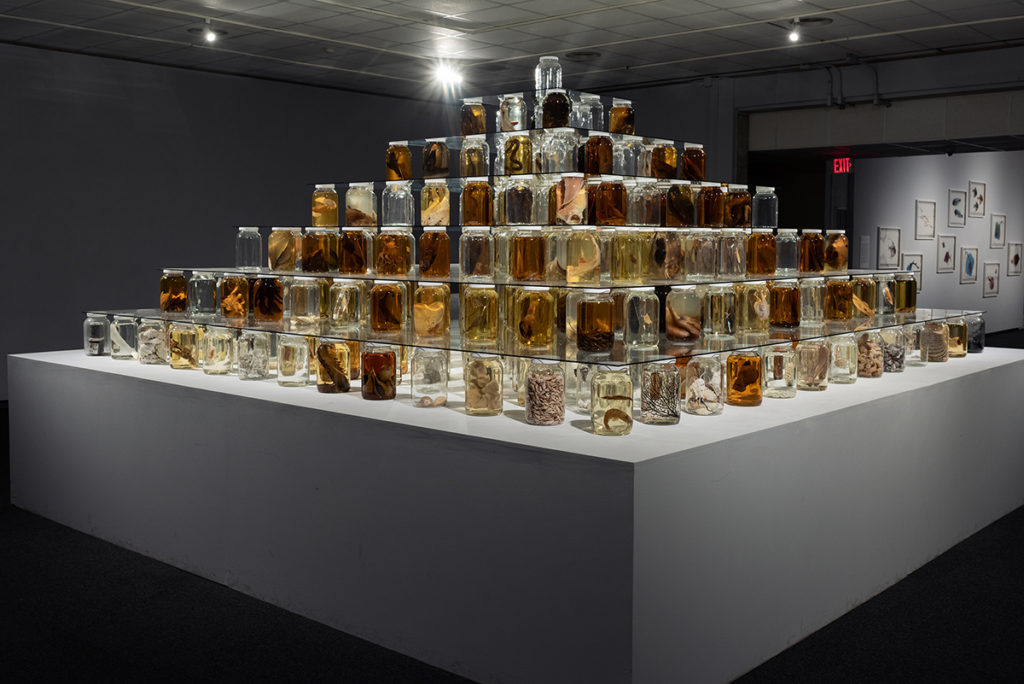
“Collapse” by Brandon Ballengee
Le Sang Noir Programming and Community Outreach
In support of Le Sang Noir, MoFA partnered with several academic departments across the university to host round table conversations around the issues of water pollution and climate change. Brandon Ballengée also hosted a field trip to the Gulf Specimen Marine Lab, where he led families through the displays and continued the conversation about water conservation. In addition, an in-gallery activity educated visitors about species impacted by the Deepwater Horizon spill and gave them an opportunity to make their own fish and add it to a habitat.
- Children make their own endangered fish
- A field trip the Gulf Specimen Marine Lab
Craft as Social Practice
October 17 – November 18, 2018
Featuring new works by eight nationally-acclaimed artists, in Craft as Social Practice, interactions and relationships built through community and audience participation are the medium. Through conversations, site visits, shared meals, and games of skill staged on the gallery floor, interactivity becomes its own aesthetic, with interviews and field documentation exhibited alongside hand-made objects. In this exhibition, socially engaged artists look to improve their community or raise awareness of pressing social and environmental issues, and invite their audiences to acknowledge others’ perspectives and to consider ways that collaborative, participatory art making can be a catalyst for social change.
Craft as Social Practice includes works by Amanda Evans, Forrest Sincoff Gard, Jeni Hanson Gard, Holly Hanessian & Michael Austin Diaz, Anna Metcalfe, Cheyenne Rudolph, and nicole gugliotti.
Craft as Social Practice Programming and Community Outreach
Several of the projects in this exhibition were participatory. Every Friday afternoon reproductive health experts worked with MoFA interns and volunteers to activate nicole gugliotti’s ceramic flower making station. Visitors sat and made ceramic flowers while volunteers facilitated conversations about abortion, birth control, and women’s healthcare. During designated times visitors could also balance a ceramic broom made by Forrest Sincoff Gard or discuss water issues while drinking tea served in Anna Metcalfe’s cups painted with participants water stories. In addition, visitors could bring home tableware made by Jeni Hanson Gard and host a meal using the special plates. Local schools were also given place settings, and K12 students were asked to have lunch with someone from another class and then reflect on the experience in a blog post. Artist lectures, performances, and other participatory events were also held.
- A poster for an evening of events
- Visitors make ceramic flowers
- Flowers made by visitors
- Cheyenne Rudolph performs with visitors
- A visitor balances a ceramic broom
Interwoven and Treasured Cloth
Fall 2018 and Spring 2019
Each semester, undergraduate students have an opportunity to curate an exhibition from the permanent collections of MoFA under the guidance of a faculty member in the Department of Art History. In the Fall of 2018 and Spring of 2019, Dr. Kristin Dowell mentored students as they researched, designed, and produced an exhibition of Native American basketry in Interwoven and textiles from Polynesia in Treasured Cloth: Women’s Art of Polynesia.
68:18 Student Protest in Print
February 15 – March 31, 2019
In May 1968, an occupation begun by a group of French students grew to one of the largest demonstrations in modern history. Workers on strike and other protesters brought Paris to a halt, and the posters and graffiti that amplified their message have become part of our visual vernacular. With original artwork from Atelier Populaire that was posted on the streets of Paris fifty years ago and contemporary prints influenced by current student-led gun violence protests, this exhibition explores the role of graphic art in political organizing. The exhibition includes a response wall where visitors can create and post their own political messages. This project was designed and organized by graduate students enrolled in a seminar taught by Meredith Lynn in the Museum and Cultural Heritage Studies program.
- The first day of the exhibition
- Response wall at the end of the exhibition
- Signs created by visitors
- Prints by Atelier Populaire
- Prints be Atelier Populaire
- Florida gun movement prints, 2018
68:18 Programming and Community Outreach
Over 400 alumni of Stoneman Douglas High School were enrolled at FSU at the time of the mass shooting there. Dealing with charged and potentially traumatic material, the student planners of 68:18 chose to include the voices of those impacted by gun violence and the ensuing protests that gripped Tallahassee. In addition to an in-gallery participation area, a documentary made by FSU students about the anti-gun violence march played in the exhibition. FSU faculty also gave guest lectures on the artwork that was used in both the protests of 1968 and 2018, and MoFA hosted a screen-printing workshop where visitors could use the techniques and tools of Atelier Populaire to print their own t shirts.
